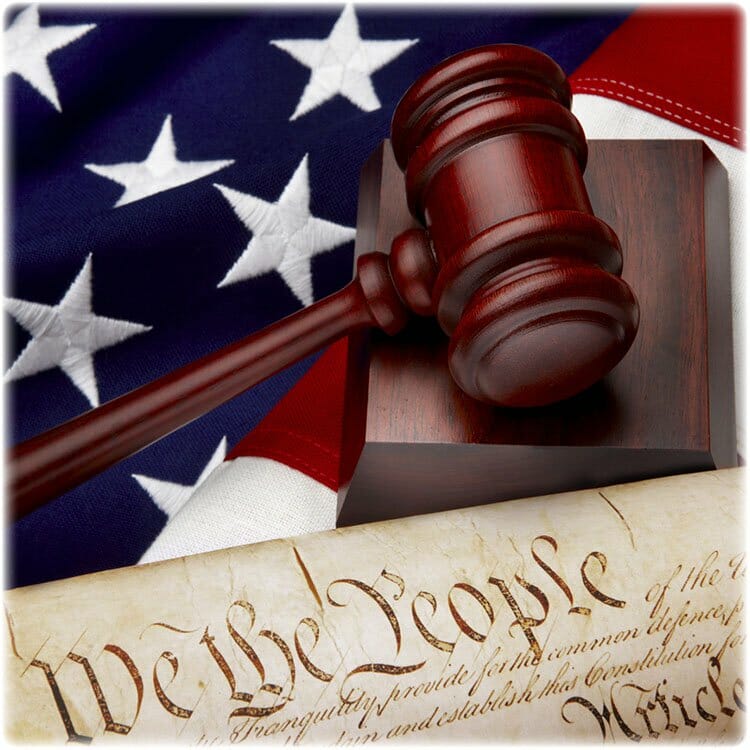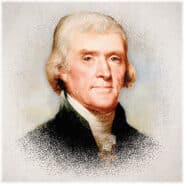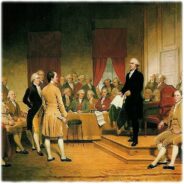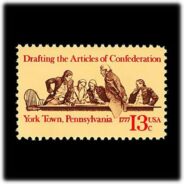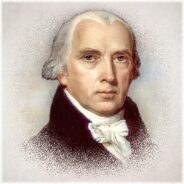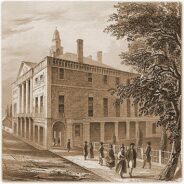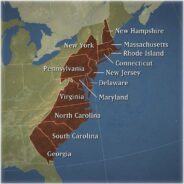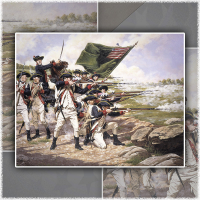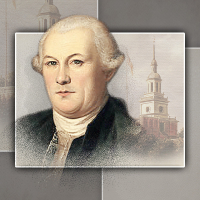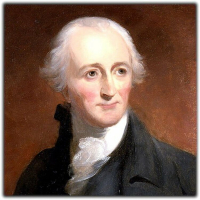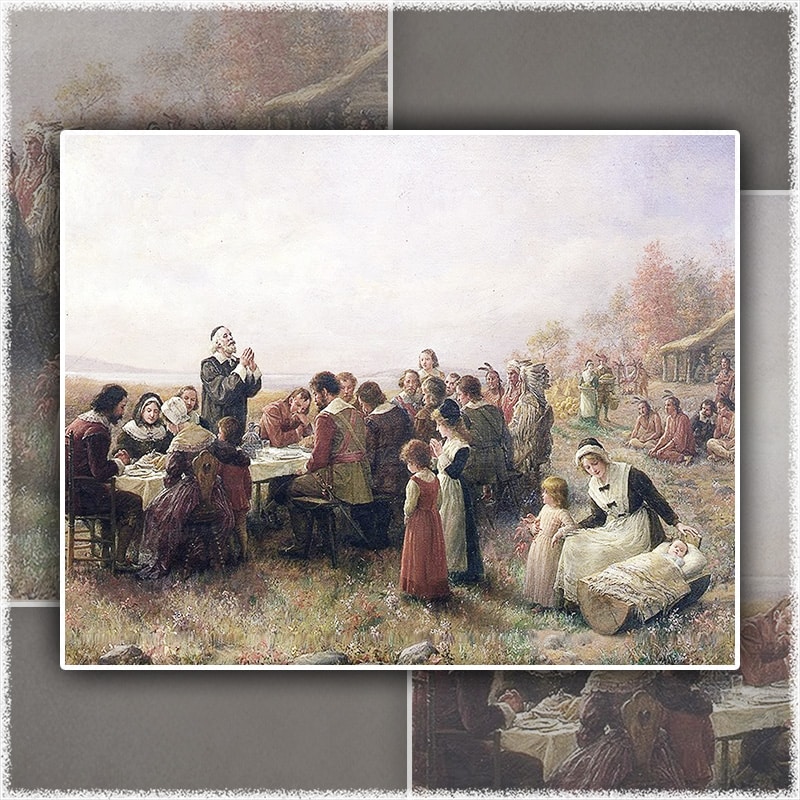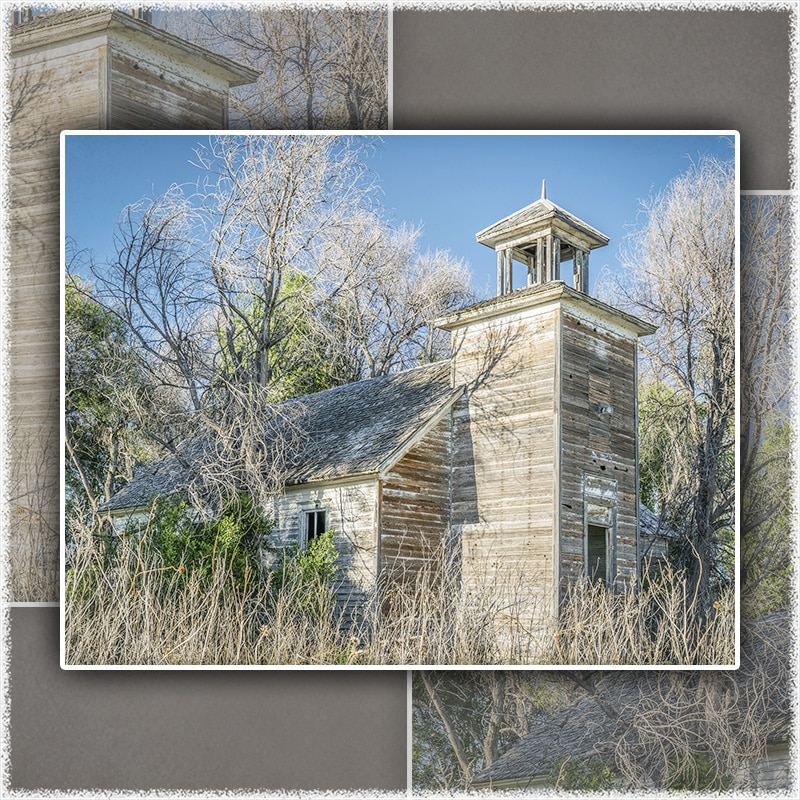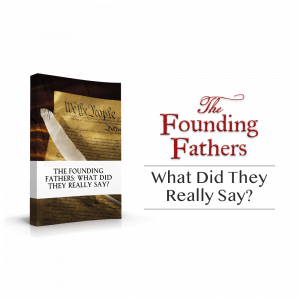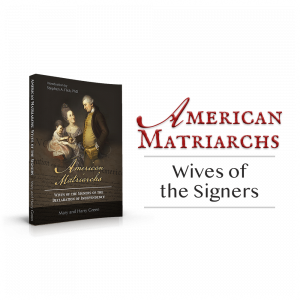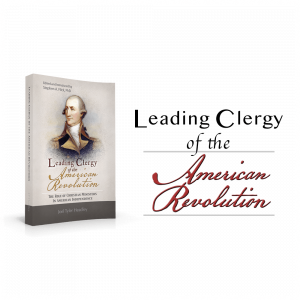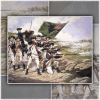Since 1947, liberal judges have reinterpreted the historical context of the First Amendment that ensured that congress (or the federal government) would not establish a state church or elevate any single denomination over any of the other Christian denominations. America's Founding Fathers regarded the First Amendment as a guarantee that the federal government would not attempt to make any one Christian denomination the dominant and preferred denomination of the nation. Since the late 1940s (and particularly the early-1960s), liberal judges have attempted to use the First Amendment as a means of pushing Christianity from the public arena and the place it has held since the inception of America. To understand whether these judges have the approval of the Constitution to interpret the First Amendment this way, we must understand what the Founding Fathers meant when they composed the First Amendment.
Article Contents
Jefferson's Meaning of the Separation
History Must Interpret the Meaning
Ratification of the Constitution
The Work of the First Congress
Understanding of First Congress
The Final Form of the Amendment
Context of Ratification and Implementation
Why the Constitutions Speaks Little of Religion
Justice Hugo Black, writing for the majority in the Supreme Court case Everson VS Board of Education (1947), greatly deviated from the historical interpretation of the First Amendment when rendering his opinion. Black and his colleagues who sided with his opinion took from the states a right they had enjoyed since the ratification of the Bill of Rights. In this opinion, Justice Black initiated an unconstitutional line of reasoning that has suppressed the truth of the First Amendment for more than half a century:
The 'establishment of religion' clause of the First Amendment means at least this: Neither a state nor the Federal Government can set up a church. Neither can pass laws which aid one religion, aid all religions or prefer one religion over another. Neither can force nor influence a person to go to or to remain away from church against his will or force him to profess a belief or disbelief in any religion. No person can be punished for entertaining or professing religious beliefs or disbeliefs, for church attendance or non-attendance. . . . Neither a state nor the Federal Government can, openly or secretly, participate in the affairs of any religious organizations or groups and vice versa. In the words of Jefferson, the clause against establishment of religion by law was intended to erect 'a wall of separation between Church and State.'[1]
Since this ruling in 1947, courts throughout America have looked to this opinion as a watershed from its historical interpretation from the days of America's Founding Fathers. Justice Black and those supporting his opinion on the Court introduced a completely new element that was and is at variance with the historical interpretation of the First Amendment. Justice Black and his colleagues inserted new law into the Constitution that the Supreme Court justices for nearly 160 years had never seen. The historic position of the Supreme Court and lower courts was summarized by Supreme Court Associate Justice, David Brewer, and his majority opinion (Holy Trinity v. United States, 1892) and subsequently enlarged upon in his book, The United States a Christian Nation.
Jefferson's Meaning of the Separation
The expression, "separation of church and state," is taken from a letter that Thomas Jefferson wrote to the "Danbury Baptist Association in the State of Connecticut." The Baptist Association had written a letter to Jefferson on October 7, 1801. In their letter, the Baptists expressed a concern that the federal government might regard the religious rights expressed in the First Amendment as given or granted by the authority of the government, and if the government had the authority to grant it, the government might believe that it possessed the authority to take it away (an alienable right). The Baptists, on the other hand, believed this right was given by God, and, therefore, could not be taken away by the federal government (it was inalienable).[2]
Thomas Jefferson responded to the letter from the Danbury Baptists on January 1, 1802, affirming the intention of the First Congress when it proposed the wording for the First Amendment. In his letter, Jefferson wrote:
. . . I contemplate with sovereign reverence that act of the whole American people which declared that their legislature should make no law respecting an establishment of religion, or prohibiting the free exercise thereof, thus building a wall of separation between church and state.[3]
Further examination of his papers reveal that Jefferson was in complete compliance with the historical interpretation of the First Amendment's refusal to establish one Christian denomination as the state or federal church, nor to allow the federal government to limit, regulate, or interfere with Christian religious expression.[4] In a letter to devoted Christian and fellow-signer of the Declaration of Independence, Dr. Benjamin Rush, Jefferson maintains this same position, remaining consistent with the First Congress by resisting the desires of certain denominational leaders to secure recognition of their denominations as the federal or national church:
. . . the clause of the Constitution which, while it secured the freedom of the press, covered also the freedom of religion, had given to the clergy a very favorite hope of obtaining an establishment of a particular form of Christianity through the United States; and as every sect believes its own form the true one, every one perhaps hoped for his own, but especially the Episcopalians and Congregationalists. The returning good sense of our country threatens abortion to their hopes and they believe that any portion of power confided to me will be exerted in opposition to their schemes. And they believe rightly.[5]
History Must Interpret the Meaning
To correctly understand the meaning of a document, one must sufficiently understand the history that surrounded its composition. Liberal Bible scholars have often embarrassed themselves by failing to study the historical context of biblical events before making their interpretations. Today, America suffers at the hands of judges who have no regard for the setting in which the Constitution and Bill of Rights (containing the First Amendment) were composed. Following the ratification of the Constitution and the Bill of Rights, America's judges rendered judgments consistent with this historical context of the writing of the First Amendment. For more than a century and a half, America's judges rendered decisions that refused federal courts the right to dictate to states in matters pertaining to religion. Eager to render judgments inconsistent with the intent of America's Founding Fathers, many contemporary judges have dismissed America's legal heritage in this matter. The historical setting of the First Amendment has been and must be the determining influence for interpreting this Amendment.
After America declared its independence from Great Britain and while she was still engaged in the war for her independence, the Second Continental Congress devised the Articles of Confederation—an agreement between the thirteen founding states that both established the United States of America as a confederation of sovereign states and served as its first constitution. But because of the limitations and inadequacies of the Articles of Confederation, the American states found it difficult to relate to each other following the Revolution.[6] To address the limitations of the Articles of Confederation, a Constitutional Convention[7] was called and convened from May 25[8] to September 17, 1787 in Philadelphia, Pennsylvania. George Washington was elected to preside over the Convention, and, though not originally intended, the result of the Convention was the United States Constitution that, subsequently, had to be ratified by the states.
Ratification of the Constitution
After a farewell banquet, the delegates to the Constitutional Convention returned home to quickly begin to organize their states to give consent to the new Constitution, though some spoke in opposition to it. As stipulated at the Convention, the Constitution could not take effect until nine of the thirteen states ratified it (Article VII).
An important hurdle had to be crossed before representatives to the Constitutional Convention would have authority to organize their states to ratify the Constitution. During the Revolutionary War, the Second Continental Congress had provided for the government of the states through the Articles of Confederation, and the Congress that was authorized by these Articles had not given approval to the Constitutional Convention to write a new form of government, but only revise and improve the Articles of Confederation. On September 20, the Congress authorized by the Articles of Confederation convened, but did not address the issue of the new Constitution until September 26 and 27. Having overstepped its authority by writing a new Constitution, the representatives to the Constitutional Convention could have censured the Articles of Confederation Congress for their efforts, but instead this Congress chose to direct state legislatures to call for conventions within their respective states to consider the matter of ratifying the newly proposed Constitution.[9]
Delaware was the first to ratify the Constitution on December 7, 1787 and the last was Rhode Island on May 29, 1790.[10] When the Congress under the Articles of Confederation convened on September 13, 1788, it certified that eleven of the states had ratified the Constitution. Steps were then taken to seat the new Constitutional government, which was first convened on March 4, 1789.
The Work of the First Congress
After the states had ratified the Constitution, members to the first Congress were selected by their respective states. The first Congress convened for a two-year period, from March 4, 1789 to March 4, 1791, first gathering in New York City at Federal Hall, then later at Congress Hall in Philadelphia. During this time, Congress' work was divided into three sessions: first session, March 4, 1789 – September 29, 1789; second session, January 4, 1790 – August 12, 1790; and third session, December 6, 1790 – March 3, 1791.
Those who opposed the new Constitution were brought into agreement with it only with the assurance that further guarantees and legislation would be made to help quiet their concerns over a federal government they believed to be too strong in its appointed powers. The attempt to quiet these fears was introduced to the first Congress by James Madison in a series of legislative articles that became the first Ten Amendments to the Constitution, also known as the Bill of Rights. The First of these Ten Amendments is the subject of our inquiry.
Understanding of First Congress
To correctly interpret American Church and state relationships today, as intended by America's Founding Fathers, interpreters must be aware of the discussions that surrounded the development of the First Amendment, and to assist in this matter, we must turn to the account of their discussions—the Congressional Record. As will be noted in reading the quotation below, the first congress did not consider the individual Amendments of the Bill of Rights in their current order. The portion of the First Amendment relating to the federal government and religion was referred to by the first congress as the "article third" or "third article." The "article third" discussed by the First Congress eventually came to hold the place of greatest importance in the First Amendment.
The following quotation is taken from the record of the first Senate and discloses the fact that the members of the First Congress did not want the federal government to have the power to set one Christian denomination above another in the relationship between the federal and state governments. It is evident that the Senate did not wish to allow the federal government (designated as "Congress") to control religious matters of the states by establishing a state church or denomination. The Senate and First Congress believed this was a matter left to the states to decide—not the federal government.
On motion to amend article third [which became part of the First Amendment], and to strike out these words: 'religion, or prohibiting the free exercise thereof,' and insert 'one religious sect or society in preference to others:'
It passed in the negative.
On motion for reconsideration:
It passed in the affirmative.
On motion that article third be stricken out:
It passed in the negative.
On motion to adopt the following, in lieu of the third article: 'Congress shall not make any law infringing the rights of conscience, or establishing any religious sect or society:'
It passed in the negative.
On motion to amend the third article, to read thus: 'Congress shall make no law establishing any particular denomination of religion in preference to another, or prohibiting the free exercise thereof, nor shall the rights of conscience be infringed:'
It passed in the negative.
On the question upon the third article as it came from the House of Representatives:
It passed in the negative.
On motion to adopt the third article proposed in the resolve of the House of Representatives, amended by striking out these words, 'nor shall the rights of conscience be infringed:'
It passed in the affirmative.[11]
The foregoing quote from the journal of the first session of the Senate clearly indicates that the first congress did not wish to give the federal government the authority to establish "any particular [Christian] denomination of religion in preference to another."
The Final Form of the Amendment
On September 25, 1789—less than three weeks after the debate in the Senate concerning establishing one Christian denomination over all the others—the final form of the Bill of Rights was prepared for ratification by the individual states. The final form of the First Amendment read as follows:
Congress shall make no law respecting an establishment of religion, or prohibiting the free exercise thereof; or abridging the freedom of speech, or of the press; or the right of the people peaceably to assemble, and to petition the Government for a redress of grievances.
The First Amendment and the first subject of this Amendment limited the federal government's authority in matters of religion in two ways—through two clauses. The first clause, "Congress shall make no law respecting an establishment of religion," is known as the "Establishment Clause." This clause prohibited the federal government from establishing one denomination over the others as the state church. The second clause, ". . . or prohibiting the free exercise thereof," is known as the "Free Exercise Clause." This second clause prohibited the federal government (Congress, Supreme Court, etc.) from interfering with citizens' rights to publically express their religious convictions—which were overwhelmingly Christian.
Context of Ratification and Implementation
The newly formed House of Representatives adopted these Amendments on August 21, 1789 followed by the Senate and a join resolution issued on September 25, 1789. Like the Constitution, the Bill of Rights required ratification by the states. Though twelve amendments were proposed by the first Congress, only ten were ratified by the states, finally achieving the statutes of Constitutional Amendments on December 15, 1791.
That contemporary judges have grossly erred in their use of the expression of "separation of Church and state" is evident by the historical setting in which the Bill of Rights became part of the United States Constitution. At the time that the first Ten Amendments were ratified and achieved the status of law in America, eleven of the thirteen states already had state churches. That no branch of the federal government raised a finger to dismantle these state churches bears further witness to the fact that the original intent of the federal government was to allow states the rights to regulate themselves in matters of religion without any attempt to place one Christian denomination over any other. Their intent was never to forbid states from allowing children to pray in classrooms and before sporting events. The historical setting of the composition and application of the First Amendment makes this perfectly clear.
Why the Constitutions Speaks Little of Religion
Secularists charge that if the Founding Fathers had intended America to be a Christian nation they would have woven elements of Christian faith and practice into the Constitution. There is a very simple reason that the federal Constitution has very little religious language: Because the state constitutions did speak fully and freely concerning Christianity. The Federalists who were hoping for a strong federal government knew that the Constitution stood little chance of ratification if it appeared a federal state church would displace their state churches.
Conclusion: The First 160 years
The first Chief Justice of the Supreme Court was John Jay, a devout Christian.[12] The Supreme Court first convened under Chief Justice Jay on February 2, 1790, which, including Justice Jay, numbered only five at that date, the sixth member (James Iredell) joining the other members of the newly established high court on May 12, 1790. From this first session, the Supreme Court never evoked the expression, "separation of Church and state," as the expression has been used by courts since 1947, indicating that the Supreme Court has the authority over states to suppress government association with public expressions of Christianity. For nearly 160 years, the Supreme Court acted in accordance with the intent of the first session of Congress that drafted the Bill of Rights, the First Amendment of which assured the states that the federal government would not interfere with the states in matters pertaining to the expression of their Christian faith.
America deserves to know its true heritage.
Please contribute today!
"Anchor Elements" are concepts, events, individuals, terms, or other important components that are featured in this article and which act as reference points for use in other articles throughout our site.
[1] "Everson v. Board of Education of the Township of Ewing," Legal Information Institute, Cornell University Law School (http://www.law.cornell.edu/supct/html/historics/USSC_CR_0330_0001_ZO.html, October 13, 2013).
[2] "From the Danbury Baptist Association," The Papers of Thomas Jefferson (Princeton University; http://jeffersonpapers.princeton.edu/selected-documents/danbury-baptist-association, October 13, 2013).
[3] "The Thomas Jefferson Papers Series 1, General Correspondence, 1651-1827; Thomas Jefferson to Danbury, Connecticut, Baptist Association, January 1, 1802, The Library of Congress (http://hdl.loc.gov/loc.mss/mtj.mtjbib010955, October 13, 2013); also see "Jefferson's Wall of Separation Letter," Constitution Society (http://www.constitution.org/tj/sep_church_state.htm, October 13, 2013).
[4] For further quotes from Jefferson on this matter, see David Barton, "The Separation of Church and State," WallBuilders (http://www.wallbuilders.com/LIBissuesArticles.asp‒id=123#R3, October 13, 2013).
[5] "From Thomas Jefferson to Benjamin Rush, 23 September 1800," National Archives, Founders Online (http://founders.archives.gov/documents/Jefferson/01-32-02-0102, October 13, 2013).
[6] The Second Continental Congress drafted and circulated what functioned as America's first constitution; it was known as the Articles of Confederation.
[7] The Constitutional Convention was also known the Philadelphia Convention, the Federal Convention, or the Grand Convention at Philadelphia.
[8] The Constitutional Convention was scheduled to begin on May 14, 1787 but only representatives from Virginia and Pennsylvania were present by that date. By May 25, representatives from seven states were present, which constituted a quorum. Eventually, twelve states were represented. Final records indicate that 74 delegates were eventually represented, 55 attended, and 39 signed the final draft of the Constitution.
[9] National Archives, "Teaching with Documents: The Ratification of the Constitution" (http://www.archives.gov/education/lessons/constitution-day/ratification.html, September 26, 2013).
[10] The order of state ratification is as follows: Delaware (December 7, 1787); Pennsylvania (December 12, 1787); New Jersey (December 18, 1787); Georgia (January 2, 1788); Connecticut (January 9, 1788); Massachusetts (February 6, 1788); Maryland (April 28, 1788); South Carolina (May 23, 1788); New Hampshire (June 21, 1788); Virginia (June 25, 1788); New York (July 26, 1788); North Carolina (November 21, 1789); Rhode Island (May 29, 1790).
[11] Journal of the First Session of the Senate of the United States of America Begun and Held at the City of New York, March 4, 1789, and in the Thirteenth Year of the Independence of the Said States (Washington: Gales and Seaton, 1820): 70, September 3, 1789. Read the Journal online: September 3, 1789, pages 69-70.
[12] Article Three of the Constitution provided for the existence and authority of the United States Supreme Court. When the Constitution was finally ratified in 1789, the states accepted the idea of the Supreme Court as envisioned by the framers of the Constitution two years earlier.
Separation of Church and State
Separation of Church and State
Separation of Church and State
Separation of Church and State
Separation of Church and State
Separation of Church and State
Separation of Church and State
Separation of Church and State
Separation of Church and State
Separation of Church and State
Separation of Church and State
Separation of Church and State
Separation of Church and State
Separation of Church and State
Separation of Church and State
Separation of Church and State
Separation of Church and State
Separation of Church and State
Separation of Church and State
Separation of Church and State
Separation of Church and State
Separation of Church and State
Separation of Church and State
Separation of Church and State
Separation of Church and State
Separation of Church and State
Separation of Church and State
Separation of Church and State
Separation of Church and State
Separation of Church and State
Separation of Church and State
Separation of Church and State
Separation of Church and State
Separation of Church and State
Separation of Church and State
Separation of Church and State
Separation of Church and State
Separation of Church and State
Podcast: 'The Truth about Separation of Church and State,' by Dr. Stephen Flick.

